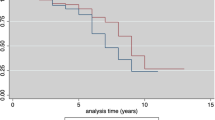Abstract
The purpose of this study was to validate through natural exposure a cut-off level of varicella zoster IgG as protective against infection with varicella zoster virus (VZV). Laboratory testing to determine VZV immune status of pregnant women exposed to varicella is recommended. Quantitative assays are now available which are sensitive and specific. More than 200 consecutive requests for screening in pregnant patients with recent varicella contacts were followed-up by questionnaire. DiaSorin LIAISON and VZV time resolved fluorescence immuno assay (VZV TRFIA) were used to measure VZV antibody level. One hundred fifty out of 209 (72%) questionnaires were returned; 14 patients developed varicella, 129 did not and seven were not known. Patients who had been given VZIG and developed varicella on follow-up had a mean antibody level before VZIG of 28 mIU/ml and 62 mIU/ml, by LIAISON and TRFIA, respectively. The mean IgG level of those that did not develop varicella was 885 and 866 mIU/ml by LIAISON and TRFIA, respectively. Those with levels <100 mIU/ml were more likely to develop chicken pox than those with levels >100 mIU/ml (relative risk of 10.4 for LIAISON and 8.8 for TRFIA). On the basis of the relatively small numbers in this study, quantitative assays, using a 100mIU/ml cut-off, can differentiate between those who are susceptible and those who are protected against exposure, however follow-up studies should include sampling for VZV DNA and IgM.



Similar content being viewed by others
References
Enders G, Miller E, Cradock-Watson J, Bolley I, Ridehaigh M (1994) Consequences of varicella and herpes zoster in pregnancy: prospective study of 1739 cases. Lancet 343:1548–1551
Alkalay AL, Pomerance JJ, Rimoin DL (1987) Fetal varicella syndrome. J Pediatr 111:320–323
Daley AJ, Thorpe S, Garland SM (2008) Varicella and the pregnant woman: prevention and management. Aust NZ J Obstet Gynaecol 48:26–33
Department of Health, Joint Committee of Vaccination and Immunisation (2006) Immunisation against infectious disease. Stationery Office Books, UK
Miller E, Marshall R, Vurdien J (1993) Epidemiology, outcome and control of varicella-zoster infection. Rev Med Microbiol 4:222–230
Chris Maple PA, Gunn A, Sellwood J, Brown DWG, Gray JJ (2009) Comparison of fifteen commercial assays for detecting varicella zoster virus IgG with reference to a time resolved fluorescence immunoassay (TRFIA) and the performance of two commercial assays for screening sera from immunocompromised individuals. J Virol Methods 155:143–149
Williams V, Gershon A, Brunell PA (1974) Serologic response to varicella-zoster membrane antigens measured by indirect immunofluorescence. J Infect Dis 130:669–672
Maple PAC, Gray J, Breuer J, Kafatos G, Parker S, Brown D (2006) Performance of a time resolved fluorescence immunoassay for measuring varicella zoster virus immunoglobulin G levels in adults and comparison with commercial enzyme immunoassays and Merck glycoprotein enzyme immunoassay. Clin Vaccine Immunol 13:214–218
Chris Maple PA, Gray J, Brown K, Brown D (2009) Performance characteristics of a quantitative, standardised varicella zoster IgG time resolved fluorescence immunoassay (VZV TRFIA) for measuring antibody following natural infection. J Virol Methods 157:90–92
Maple PAC, Rathod P, Smit E, Gray J, Brown D, Boxall EH (2009) Comparison of the performance of the LIAISON VZV-IgG and VIDAS automated enzyme linked fluorescent immunoassays with reference to a VZV-IgG time-resolved fluorescence immunoassay and implications of choice of cut-off for LIAISON assay. J Clin Virol 44:9–14
McDonald SLR, Maple PAC, Andrews N et al (2011) Evaluation of the time resolved fluorescence immunoassay (TRFIA) for the detection of varicella zoster virus (VZV) antibodies following vaccination of healthcare workers. J Virol Methods 172:60–65. doi:10.1016/jviromet.2010.12.021
MacMahon E, Brown LJ, Bexley S, Snashall DC, Patel D (2004) Identification of potential candidates for varicella vaccination by history: questionnaire and seroprevalence study. BMJ 329:551–552
CDC (2008) Manual for surveillance of VPD, ch. 17: varicella.http://www.cdc.gov/vaccines/pubs/surv-manual/chpt17-varicella.htm. Accessed 16 March 2011
Hall S, Maupan T, Seward J (2002) Second varicella infections: are they more common than previously thought? Pediatrics 109:1068–1073
Pinot de Moira A, Edmunds WJ, Breuer J (2006) The cost effectiveness of antenatal varicella screening with post partum vaccination of susceptibles. Vaccine 24:1298–1307
Troughton JA, Crealey G, Crawford V, Coyle PV (2009) Management of varicella contacts in pregnancy: VZIG or vaccination. J Clin Virol 46:345–348
Acknowledgements
This study was supported by the HPA R&D Pump Priming and Small Scientific Initiatives Fund.
Conflicts of interest
There are no competing interests and ethical approval was not required.
Author information
Authors and Affiliations
Corresponding author
Rights and permissions
About this article
Cite this article
Boxall, E.H., Maple, P.A.C., Rathod, P. et al. Follow-up of pregnant women exposed to chicken pox: an audit of relationship between level of antibody and development of chicken pox. Eur J Clin Microbiol Infect Dis 30, 1193–1200 (2011). https://doi.org/10.1007/s10096-011-1211-4
Received:
Accepted:
Published:
Issue Date:
DOI: https://doi.org/10.1007/s10096-011-1211-4




